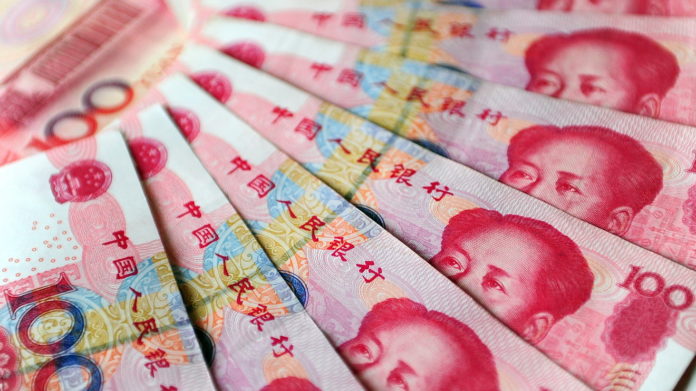Weakness in China’s currency and a rout in its stock market in 2018 are raising warning bells among investors haunted by memories of the August 2015 devaluation scare and the ensuing volatility that spooked investors.
Underscoring those fears, China’s officials reported that gross domestic product grew at a slower pace than anticipated for the third quarter. Data released late Thursday showed its economy expanding 6.5% year-over-year between July and September, compared with 6.6% expected and 6.7% in the prior period.
The GDP report represented the weakest read since 2009 and was followed by a parade of statements from the People’s Bank of China, its securities regulator and banking and insurance regulator in support of the stock market and what was billed by that cohort as China’s positive economic fundamentals.
Those comments calmed markets and led Asian equities to end Friday’s session higher. Over the weekend, China’s President Xi Jinping stressed his support for the private sector, which gave stocks another boost on Monday.
Still, looking at the year so far, both China’s major stock market benchmarks and the yuan have suffered—and it market participants worry that Friday’s rebound belies grave concerns that further economic and stock-market pain lie ahead.
China’s Shanghai Composite
SHCOMP, +4.09%
—which Friday and Monday finished higher and reversed a brutal Thursday trading day—has dropped almost 22% in the year so far, according to FactSet. According to Capital Economics’ markets economist Oliver Jones, pain could intensify as the outlook for China’s economy and the U.S.-China trade war worsens.
Read: Opinion: The S&P 500 is headed higher, but a trade deal won’t save Chinese stocks
A weak currency, which makes Chinese products more competitive on the global market—and offsets some of the impact of U.S. tariffs—could help China stave off some of the slowdown. But as the yuan still hovers near a psychologically important 7.00 mark, worries about how authorities will handle the situation are on the rise.
See: Here’s why investors shouldn’t take their eyes off China’s yuan
“A steady depreciation of the yuan could help Beijing cushion the impacts of U.S. tariffs by boosting export competitiveness—ultimately supporting economic growth,” said Lukman Otunuga, research analyst at FXTM. “However, such a move is likely to fuel capital outflows, spark fears of a currency war and pressure [other] emerging markets.”
“I think China is trying to walk a fine balance of easing monetary and fiscal policy to compensate for the negative effects of the trade war,” said Danske Bank chief China economist Allan von Mehren in emailed comments. Overdoing it on the easing side, he added, would “risk igniting capital outflows due to yuan devaluation and also delay the deleveraging process too much.”
On Thursday, the yuan
USDCNY, +0.2554%
USDCNH, +0.2264%
briefly touched its lowest level against the dollar since January 2017 last week Thursday after the U.S. Treasury refrained from labeling China a currency manipulator in its biannual report on foreign exchange practices late Wednesday. One dollar last bought 6.9475 yuan in Beijing and 6.9470 yuan offshore on Friday.
While the currency has sold off further versus the U.S. dollar than investors may have expected at the start of the year, but the move has been widely attributed to market forces. In light of a strengthening greenback
DXY, +0.36%
particularly in the second quarter of the year, emerging markets, including China, sold off. The yuan has dropped more than 6% versus the dollar so far this year, both in Beijing and in the more freely traded offshore currency.
“Regardless, a scenario where the yuan sharply weakens toward 7.00 [yuan per dollar] is poised to fuel concerns over the health of the world’s second largest economy,” Otunuga said.
He said that the Chinese yuan breaching the psychological level would weigh on global sentiment, with Asian emerging-market currencies sitting in the hot zone. Those are risk of the effect of China contagion include the South Korean won
USDKRW, +0.09%
Taiwanese dollar
USDTWD, +0.0841%
and Malaysian ringgit
USDMYR, +0.0241%
and the respective stock markets in those regions are also likely to be slammed.
The fragility of China’s currency have been at least partly a byproduct of monetary tightening from the Federal Reserve and easing from the People’s Bank of China, market participants said. But the PBOC’s policy-easing measures and shore up its economy likely won’t bear fruit until the middle of next-year, Jones said.
Von Mehren expects the dollar to move as high as 7.20 versus the yuan in onshore trade over the coming 12 months as the Fed’s tightening and the PBOC’s easing continue to diverge.
It is that divergence that could ultimately wreak havoc on China and spark a redux of August 2015.
Want news about Asia delivered to your inbox? Subscribe to MarketWatch’s free Asia Daily newsletter. Sign up here.
Source : MTV












